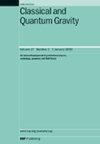扁长方体Au-Pt合金试验质量用于空间引力波探测的可能性分析
IF 3.6
3区 物理与天体物理
Q2 ASTRONOMY & ASTROPHYSICS
引用次数: 0
摘要
天基引力波探测一般采用公斤级立方测试质量。重力卫星平长方体试验质量具有重量轻、剩余磁矩小、预载力要求低、地面试验方便等优点。本文分析了加速度噪声与量纲的关系,认为扁长方体Au-Pt合金的测试质量很有希望用于天基引力波探测。本文提出的方案采用了一种新的静电控制策略,避免了敏感方向旋转静电控制的噪声。基于该方案,理论分析表明,受布朗噪声、随机充电噪声和磁噪声的限制,扁平长方体Au-Pt合金的测试质量可以达到约为。最后,本文给出了测试质量在不同维度下的性能,发现在低频范围内,沿敏感方向增加边长是最有效的性能优化。扁长方体Au-Pt测试质量代表了一种潜在的空间引力波探测惯性传感器方案。本文章由计算机程序翻译,如有差异,请以英文原文为准。
Possibility analysis of a flat cuboid Au–Pt alloy test mass employed in space gravitational wave detection
Space-based gravitational wave detection generally employs kilogram-scale cubic test masses. The flat cuboid test mass for gravity satellites has the advantages of lightweight, low remanent magnetic moment, low preload force requirement and convenient ground testing. The paper analyses the relationship between acceleration noise and dimensions, identifying that the flat cuboid Au–Pt alloy test mass is promising for space-based gravitational wave detection. The scheme proposed in the paper adopts a new electrostatic control strategy, avoiding the noise of rotating electrostatic control in a sensitive direction. Based on this scheme, theoretical analysis shows that the flat cuboid Au–Pt alloy test mass can achieve a performance of about between to , limited by Brownian noise, random charging noise and magnetic noise. Finally, the paper presents the performance of test masses in different dimensions, finding that increasing the side length along the sensitive direction is the most efficient optimisation for performance in the low frequency range. The flat cuboid Au–Pt test mass represents a potential inertial sensor scheme for space-based gravitational wave detection.
求助全文
通过发布文献求助,成功后即可免费获取论文全文。
去求助
来源期刊

Classical and Quantum Gravity
物理-天文与天体物理
CiteScore
7.00
自引率
8.60%
发文量
301
审稿时长
2-4 weeks
期刊介绍:
Classical and Quantum Gravity is an established journal for physicists, mathematicians and cosmologists in the fields of gravitation and the theory of spacetime. The journal is now the acknowledged world leader in classical relativity and all areas of quantum gravity.
 求助内容:
求助内容: 应助结果提醒方式:
应助结果提醒方式:


